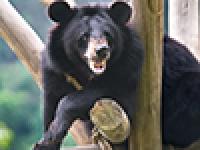The horrors of Maoshan – Part 1
04 February 2008, 21:34PM
Recently, I visited Maoshan Live Animal Market in Guangzhou with two of our China team, Christie and Rainbow. Such visits are probably the hardest part of our work at Animals Asia, but they’re also among the most important. We must keep monitoring this situation and exposing the truth about these hell-holes. These are my notes from the visit:
It’s 8am and I just don’t know how Christie and Rainbow can cope with the pain. You feel it in every fibre of your body, as you breathe the rancid, acrid smell of disease and taste the dust of death and decay. It lingers for hours after you've left one of these obscene live animal markets in China.
The place is Maoshan Market in the southern province of Guangdong and even as the taxi pulls up outside the open courtyard the screams of terrified animals makes us wince. These cries echo around each avenue of the market until we finally meet the eyes of petrified dogs and cats that are minutes or hours from death. Panting from thirst and dehydration, crying with terror, confusion and pain, their suffering is profound. Sometimes their tails wag in hopeful anticipation that the soft apologies of people recording their pain will lead to release – until their eyes fade once again into hopeless reality and they turn away.
We promise they will never die in vain. Rainbow is saying “please look at the camera; let me turn your agony into change for the animals of the future”. I can only say sorry to the eyes that turn my way – and I do out loud – and try to reassure them that their next life will be better.
Hundreds, possibly thousands, of dogs are piled into tiny wire mesh cages in pyramids teetering high into the air on the backs of the trucks. Cats are stacked in cages that wobble precariously on industrial weigh-scales as their mass of body weight is calculated for the local restaurants.
One cage suddenly breaks open as it crashes from the truck to the concrete floor below and all hell breaks loose as three cats find the opening and dash out into the lane, desperately trying to flee. The traders don’t miss a thing and surround the terrified cats, herding them into a corner, before grasping them around the necks with wire tongs and smashing them onto the ground until their bodies go limp. A young ginger male twitches for a few seconds and becomes still. A black-and-white cat convulses wildly in a semi-conscious state, blood pouring from her mouth, nose and broken legs before waking more fully and trying to scramble under a truck. Her adrenalin allows her one last chance of escape. The traders let her go, anticipating perhaps that she will soon die of shock and pain and isn't worth chasing. We try to find her, but it’s an impossible task in the maze of animals and people and we pray that her agony will end soon.
Animals, both dead and alive, are squashed together, suffocating in cages the size of small suitcases – each movement of one causing others to scream in pain as broken and wounded limbs are nudged or sat upon. So many dogs are sick and suffering from the ravages of parvovirus or distemper; several wheezing last breaths, while others are now lifeless in their cages. As we continue taking pictures we hear a weak and plaintive mewing, and walk over to what we think will be a cage of mother and kittens. Instead, we nearly tread on a tiny newborn puppy, recently born of a sick or petrified mother and simply tossed away on the floor by the men.
His body is cold, but he’s breathing and, wrapping him in the fabric of an old umbrella we find on the floor, I hold him close to my body, trying to raise his temperature. Less than 30 minutes later, Rainbow finds another – a tiny newborn black-and-white female, again with umbilical cord attached, and a body temperature even lower than the first. Two tiny lives to take later to our friend John Wu the vet whom we had just said goodbye to the evening before at our annual China Companion Animal Symposium.

Recent Posts
Festive fun at our sanctuaries
December 19, 2024

